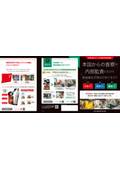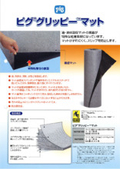Anti-slip mat "Piggrippy Mat" [Prevention of slips due to oil and water]
The special adhesive material on the back prevents the mat from slipping and keeps it in place!
**Features** - Absorbs oil and water It absorbs oil, coolant, solvents, and water. - Wear resistance and durability The surface of the mat is made of spunbond non-woven fabric sewn with polyester stitching, providing excellent wear resistance and durability. - Adhesive backing The back of the mat is made of adhesive material, preventing it from shifting or bending even when walked on or when carts pass over it. The back is coated to prevent absorbed liquids from leaking onto the floor. - Easy to cut It can be cut to the desired size with scissors or a cutter. - Flame retardant compliant product
basic information
【Usage Instructions】 - Please store in a dry indoor environment at room temperature, avoiding ultraviolet light. 【Note】 - Pig products are manufactured in the United States and their sizes are managed in inches. When sold in Japan, they are displayed in metric units, which may result in slight discrepancies. - The absorption amount is calculated based on test results from the manufacturer. If the conditions of use differ from the test environment, the stated absorption amount (experimental value) may differ. *For more details, please request a catalog or view the PDF data available for download.
Price range
Delivery Time
Model number/Brand name
NEW PIG CORPORATION
Applications/Examples of results
- For wiping feet at factory corridors and office entrances - Backyard around the kitchen
Line up(3)
| Model number | overview |
|---|---|
| MAT32100 | Size: Width 81cm × Length 30m / Thickness 3mm / Quantity: 1 roll/bag / Weight: Approximately 12.2kg/bag / Absorption capacity: Approximately 60ℓ/bag |
| MAT3250 | Size: Width 81cm × Length 15m / Thickness 3mm / Quantity: 1 roll/bag / Weight: Approximately 6.1kg/bag / Absorption capacity: Approximately 30ℓ/bag |
| MAT3220G | Size: Height 81cm × Width 50cm / Thickness 3mm / Quantity: 15 sheets/box / Weight: Approximately 2.8kg/box / Absorption capacity: Approximately 1ℓ/sheet, approximately 15ℓ/box |
catalog(3)
Download All Catalogs
News about this product(52)
-

Introducing products for rainwater and condensation measures during the upcoming rainy season!
●Measures to Prevent Slips at Entrances and Aisles On rainy days, the ground becomes slippery due to moisture brought in from outside. To prevent accidents where employees or customers might slip and fall, it is essential to implement measures that keep the floor dry and ensure safety and comfort underfoot on rainy days. ●Measures to Prevent Condensation Around Walls and Refrigeration Equipment During the rainy season, high humidity can lead to condensation, which, if left unattended, can cause water to drip and spread, becoming a slip and fall hazard. However, using rags to clean up the water can detract from the aesthetics and lead to mold growth due to bacterial proliferation. Therefore, it is necessary to find efficient ways to absorb leaks while also considering the appearance.
-

Winter season sees a sharp increase in falls; preventing accidents in advance【Environmental Measures VOL.2】
Labor accidents (work-related injuries) refer to situations where workers are injured, become ill, or die due to work or commuting. Specifically, the following situations are included: 1. Occupational accidents: When workers are injured, become ill, or die due to their work. 2. Commuting accidents: When workers are injured, become ill, or die due to commuting. To reduce labor accidents, there exists a medium-term plan that outlines key initiatives for the government, businesses, and workers, and this information is useful for the prevention and countermeasures of labor accidents. Additionally, businesses are required to continue their efforts to ensure a safe workplace environment. This time, we will focus on the most common type of labor accident, falls, and introduce measures for their prevention.
-

Preventing Falls and Accidents Before They Occur [Environmental Measures VOL.2]
Labor accidents (work-related injuries) refer to situations where workers are injured, become ill, or die due to work or commuting. Specifically, the following situations are included: 1. Occupational accidents: When workers are injured, become ill, or die due to their work. 2. Commuting accidents: When workers are injured, become ill, or die due to commuting. To reduce labor accidents, there is a medium-term plan established by the government, businesses, and workers that focuses on key issues, and this information is useful for the prevention and measures against labor accidents. Additionally, businesses are required to continue their efforts to ensure a safe workplace environment. This time, we will focus on the most common type of labor accident, falls, and introduce preventive measures for them.
-

Introducing products for rainwater and condensation prevention during the rainy season!
● Measures to Prevent Slips at Entrances and Aisles On rainy days, the ground becomes slippery due to moisture brought in from outside. To prevent accidents where employees or customers might slip and fall, it is necessary to implement measures that keep the floor dry and ensure safety and comfort underfoot on rainy days. ● Measures to Prevent Condensation Around Walls and Refrigeration Equipment During the rainy season, high humidity can lead to condensation, which, if left unattended, can cause water to drip and spread, becoming a slip and fall hazard. However, addressing water stains with rags can compromise aesthetics and lead to mold growth due to bacterial proliferation. Therefore, it is essential to efficiently absorb leaks while also considering the visual appearance.
-

Introducing products for rainwater and condensation prevention during the rainy season!
● Measures to Prevent Slips at Entrances and Aisles On rainy days, the ground becomes slippery due to water brought in from outside. To prevent accidents where employees or customers might slip and fall, it is necessary to implement measures that keep the floor dry and ensure safety and comfort underfoot on rainy days. ● Measures to Prevent Condensation Around Walls and Refrigeration Equipment During the rainy season, high humidity can lead to condensation, which, if left unattended, can cause water to drip and spread, becoming a factor for slips and falls. However, addressing water stains with rags can compromise aesthetics and lead to mold growth due to bacterial proliferation. Therefore, it is essential to find efficient ways to absorb leaks while also considering appearance.
Recommended products
Distributors
Since our founding, we have been importing and selling various products, including oil and liquid absorbents, with the desire to "provide products that contribute to the improvement of the working environment and the enhancement of health and safety." For many years, we have played a pioneering role in promoting the importance of "environmental improvement and health and safety" in the industrial sector through educational activities for those working on-site. Currently, our products are used not only in the industrial sector but also by customers in various industries, including supermarkets, restaurants, schools and research facilities, and government agencies.

















































